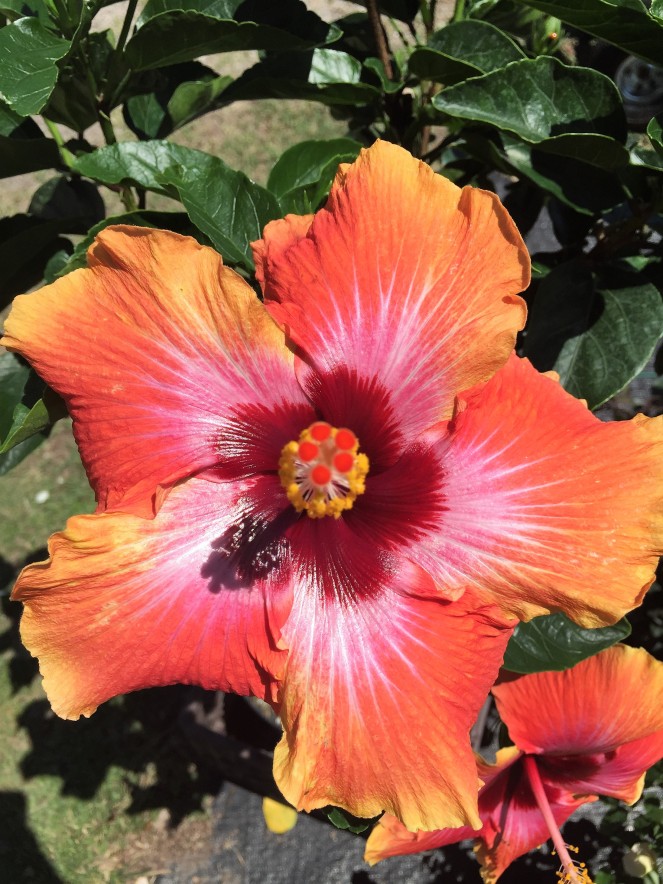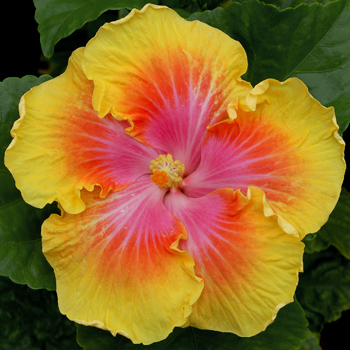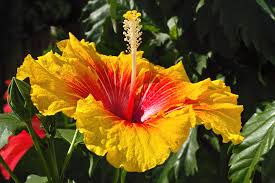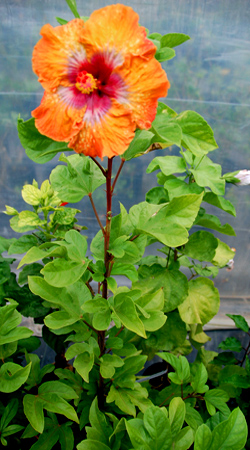Finally, this tropical Fiesta Hibiscus beauty is enhancing our front yard.

A sensational tropical shrub with large, exotic, color-changing blooms. The showy flowers have bright orange petals with crinkled edges and quickly change after opening, developing softer golden margins, and a white center with a blush-red eye. Well-suited to use as a hedge, screen, or container specimen. A frost-tender evergreen.

History
These large, eye-catching, dinner-plate sized hibiscus represent the words “tropical flower” better than any other. Originating in Asia and the Pacific Islands, Hibiscus is the national flower of Malaysia and the state flower of Hawaii. Decades of intense cross-breeding with the rosa sinensis species has produced some unbelievable multi-colored blooms. The American Hibiscus Society was formed in 1950 to promote, develop and improve upon the hundreds of varieties that were quickly emerging.

Single vs. Double
There is both single and double flowering tropical hibiscus in the rosa sinensis species. The ‘Fancy’ cultivars have growth habits of both upright and spreading. Within this group, reside two general forms: the brightly colored, usually sold colored single blooms (sometimes double) that propagate easily and are often used as seasonal potted plants as well as tropical landscape shrubs. These are often sheared to hedges in frost-free landscapes.
The second form has much larger blooms, which have a diverse mixture of colors and patterns usually single but sometimes double and are often delightfully eye-catching in their beauty. These plants make excellent container plants where they often can be enjoyed on a deck or patio or grown inside year-round in the northern climates. Their abundant array of colors are exciting to watch as many will turn different colors as the blooms age.
The multi-colored blooming hibiscus plants are often slower in growth when compared to their landscape counterparts and a bit more difficult to propagate. At Logee’s, we focus on the multi-colored flowering varieties because of their outrageous beauty.

Light Level
The cultural requirements are the same for both types of hibiscus. They require full sun for optimum growth but they will grow and flower under the partial sun that is half a day or more of direct sunlight. Of course, flower production does suffer some. For best results, a southern exposure with full sun will produce the most flowers over a season. As the days shorten, during winter in the north, often times plants will stop bud formation as the light intensity is not strong enough. Flower buds can fall off as the plant as it doesn’t have the energy to continue their development.

Temperature
Hibiscus need warm temperatures: Above 60°F or higher is preferable, although they can take dips into the 40’s or high 30’s. Do not grow under continuous cool temperatures because they will suffer and even die.

Water requirements
At Logee’s, we grow hibiscus with a wet to almost dry cycle when watering them. Simply allow the soil to become visually dry between waterings (but avoid a severe wilt) and then thoroughly saturate the potting mix. If this is done on a constant basis, the plants will thrive and the root systems will remain healthy.

Fertilizer
As hibiscus plants are relatively fast growers, they need regular applications of fertilizers throughout the growing season. A balanced fertilizer, either in a liquid form which is added to the water or a granular organic that is top dressed on the soil, will do the trick. Formulations like a 7-9-5 with trace minerals or an organic 6-4-6 will produce the most flowers and growth. Also, a pearled, slow release fertilizer works well to release nutrients continuously over a couple of months. Remember during the active growing season, spring to fall, hibiscus needs consistent fertilization for the highest flower production.

Soil Requirements
Most peat-based potting mixes that are available work well for growing hibiscus. They are slightly acidic and generally have a starter fertilizer included in their mixture. The standard potting mix is a combination of peat, perlite, and vermiculite.

Insects
Hibiscus plants are susceptible to various insects. Whitefly, spider mites, and aphids are the most common, along with thrip under certain conditions. It’s important to monitor the plants closely, especially when they come inside from their outdoor summer growth. A spray with neem oil can eradicate most problems but it’s best to do preventative sprayings before their move inside.

Pruning
Pruning needs to be done to encourage a bushy form and maintain height and size. This can be done from early spring to early fall, although pruning will slow down flowering as the buds form on the growing tips. Late winter/early spring pruning will give time for the new growth to form flower buds.
That’s it. Now it is your turn to enjoy the burst of daily color. Perhaps you will incorporate hibiscus flowers in your own household. It is pretty easy, indeed.
Make it a colorful day, dear friends.
Luda, at PlantsandBeyond.com🌿
©PlantsandBeyond.com
Disclosure: The images used in this post (except for the Header Image) do not belong to Plantsandbeyond.
http://edis.ifas.ufl.edu/ep245
http://gardeningsolutions.ifas.ufl.edu/plants/ornamentals/hibiscus.html


Beautiful
LikeLiked by 2 people
WOW!!! So beautiful.
LikeLiked by 1 person
Awe, thank you !!!
LikeLiked by 1 person
You’re welcome.
LikeLiked by 1 person
Gorgeous!❤
LikeLike
Wish I could grow these – I’ve admired them on visits to warmer climes. They’re lovely!
LikeLiked by 1 person
Thank you, Eliza!!!
LikeLike
On my 12 grade we used this to study flowers. You brought back old memories ❤️
LikeLiked by 1 person
Wow – you must have loved your classes- I would 😉
LikeLiked by 1 person
Yes I did 😊🌸
LikeLike
Aren’t these just beautiful! I am always amazed by the craftsmanship of God. Something so intricate, and perfect. It is truly miraculous 🙂
LikeLiked by 1 person
You are so right, Margaret. Makes me wonder all day long of such skill and grace-also thankful G-d is sharing such beauty with us
LikeLiked by 1 person
Great info ! Love them in all their colours!!!🌺💙🌺
LikeLiked by 2 people
💕🤗☀️🤗💕
LikeLike
Gorgeous blossoms !
LikeLiked by 1 person
Thank you, Megala !!!
LikeLiked by 1 person
You are a treasure of information and inspiration!
(*runs to make list for potting hibiscus*)
LikeLiked by 2 people
Awww- you are the best , Mel!!🤗💕😘💕🤗
LikeLiked by 1 person
I love that flower! Happy and sexy! Also delicious. 😉
LikeLiked by 1 person
Ha! Unbeatable combo 🙂
LikeLiked by 1 person
Woww 💛
LikeLiked by 1 person
🤗💕🤗🌿🤗💕🤗
LikeLiked by 1 person
So gorgeous!
LikeLiked by 1 person
Thank you, Diana !!!
LikeLiked by 1 person
Most welcome, my dear friend! 💙
LikeLiked by 1 person
💕🌿💚🌿💕
LikeLiked by 1 person
They are beauties, very opulent flowers!
LikeLiked by 1 person
Thank you so much Andrea
LikeLiked by 1 person
Beautiful!
LikeLiked by 1 person
💕✨💕 thank you !
LikeLiked by 1 person
These are absolutely divine! They would make a beautiful antique paper! 💞💗🌿 love your knowledge!
LikeLiked by 1 person
Aha! Anything that you make will make the best wallpaper, sweetest Lisa! Would love to see anything that you create!
LikeLiked by 1 person
More coming your way 😘🌿
LikeLiked by 1 person
Omg- I am so grateful to know you !!!! Kiiiiisssssses abs huuuuuuugggs
LikeLike
Wonderful informative post,loved it.
LikeLiked by 1 person
Thank you so much !
LikeLiked by 1 person
Wow fabulous photos the Hibiscus colours are amazing and as always valuable tips on care and growth. Blessings
LikeLiked by 1 person
Blessings to you to, Nanette! Have a wonderful day
LikeLiked by 1 person
An excellent, colorful post! Your knowledge is so vast!❤
LikeLiked by 1 person
You are so sweet, Richa🤗💚🤗
LikeLiked by 1 person
Wow it really is a beauty
LikeLiked by 1 person
Thank you so much, Jicg
LikeLike
Thanks for your like of my article, “End Times 15;” you are very kind. Please keep up your good work.
LikeLiked by 1 person